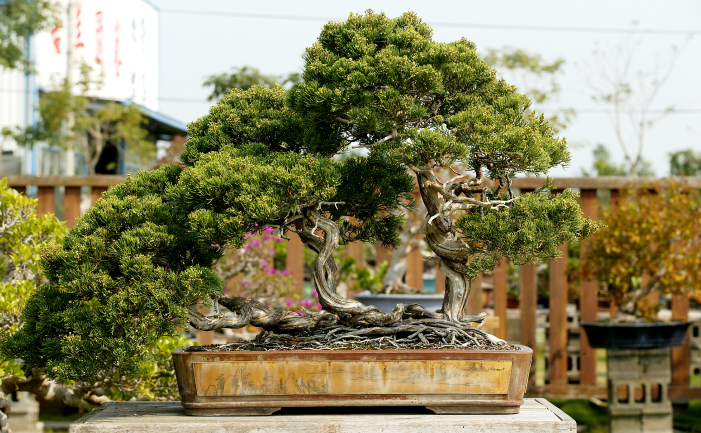
Bonsai artists try to create the impression of very old, ancient trees, but many of these trees are not very old at all. Don showed how to fake up some bonsai using two ordinary plants from the local nursery.
The plants
Plants traditionally used for bonsai include: camellia, Chinese elm, dwarf pomegranate, English box, fig, flowering quince, fuchsia, Japanese black pine, Japanese maple, juniper, star magnolia, wisteria and zelkova. Don chose two junipers for his quick bonsai demonstration:
Juniper (Juniperus chinensis ‘Blue Point’)
An evergreen tree with dense, blue-green foliage and a natural pyramidal habit. It grows to around 3m (10′) tall and 1.2m (4′) wide, and keeps its shape without pruning. It likes a position in full to part sun, and moist, well-drained soil.
Dwarf juniper (Juniperus procumbens ‘Nana’)
A slow-growing, dwarf juniper, which forms a dense mat of blue-green foliage up to 1.5m (5′) wide. It likes full sun or part shade and well-drained soil. This plant is good as a groundcover, as a bonsai, in rock gardens and cascading over walls.
Pruning steps
Don removed all the very low branches from the ‘Blue Point’ juniper, to expose its trunk. While doing this he noticed that the plant had two trunks. He decided to make a twin-trunked tree, as you often see those in nature.
Next, Don cut off any spindly, unsightly or unnecessary branches. He also shortened any branches that were too tall. In general, he aimed for a triangular shape.
Big, solid branches were wired and bent out to create the look of an ancient tree. To do this, Don used aluminium, copper-coated wire. Wiring can be left for six months to a year for evergreen trees but should be checked now and again to make sure it does not cut into the bark.
The dwarf juniper was pruned, wired and bent over the side until it resembled a tree you might see on a craggy mountain, clinging to a piece of rock and fighting against the wind.
The two bonsai plants were watered well. They were put in a shady, protected position for about two or three weeks, to help them recover from the shock of pruning. (Note: Bonsai are not indoor plants. They are outdoor plants and need careful watering.)
Further information
100g of copper-coated aluminium wire costs about $5.50.


